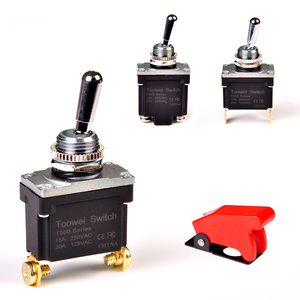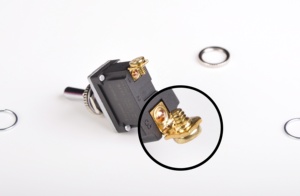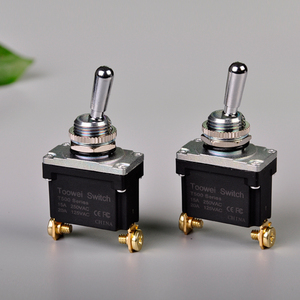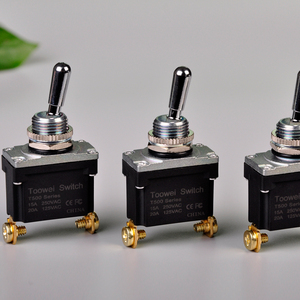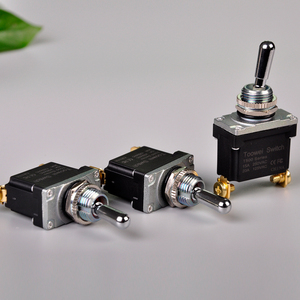Types of Sunroof Switches
A sunroof switch is a small but crucial component that controls the movement of your vehicle's sunroof, allowing it to open, close, slide, or tilt. Different vehicle designs incorporate various types of sunroof switches to enhance user experience and functionality.
Slide Rail Switch
The most common type found in most vehicles, typically located on the overhead console for easy access. These switches feature multiple positions that correspond to different sunroof functions.
Best for: Common passenger vehicles, user-friendly operation
Rotary Switch
Designed as a dial or knob that controls the sunroof through rotation movements. These switches offer more precise control and are often featured in luxury vehicles.
Best for: Premium vehicles, precise control requirements
Toggle Switch
Simple switches with an on/off design commonly used in vehicles with manual sunroofs. They may slide or flip up/down to control basic sunroof functions.
Best for: Basic sunroof systems, simple operation needs
Push Button Switch
Features single or multiple buttons programmed for specific sunroof functions like complete closing, full opening, or tilting. Often integrated with the vehicle's central control system.
Best for: Advanced sunroof systems, modern vehicle interfaces
Multi-function Control Switch
Controls multiple features beyond just the sunroof, such as interior lights, windows, or roof blinds. Enhances convenience by centralizing control of various functions.
Best for: Modern luxury vehicles, integrated control systems
Expert Tip: When replacing a sunroof switch, always consider compatibility with your vehicle's specific sunroof mechanism. Different sunroof designs (tilt, slide, panoramic) have varying operational requirements and may need specific switch types for proper functionality.
| Switch Type | Operation Method | Common Applications | Key Benefits |
|---|---|---|---|
| Slide Rail Switch | Sliding motion | Most standard vehicles | Intuitive use, widely available |
| Rotary Switch | Rotating/turning motion | Luxury vehicles | Precise control, premium feel |
| Toggle Switch | Flipping motion | Vehicles with manual sunroofs | Simple design, reliable operation |
| Push Button Switch | Pressing motion | Modern vehicles with advanced systems | Programmable functions, clean design |
| Multi-function Control | Various inputs | High-end modern vehicles | Integrated control, space efficiency |
Specifications and Maintenance
Understanding the specifications of different sunroof switches helps in selecting the right component for your vehicle. Below are specifications for popular vehicle models:
| Vehicle Model | Switch Type | Key Features | Material | Compatibility |
|---|---|---|---|---|
| VW Passat B6 | Rotary Switch | Clockwise/counterclockwise control, auto-close function | High-quality plastic, metal contacts | Passat B6 models with panoramic sunroof |
| Golf 5/Jetta 5/EOS | Multi-function Control | Open, close, tilt, slide functions | Durable polymer composite | Golf 5, Jetta 5, and EOS models |
| Skoda Octavia II | Push Button Switch | Modern design, integrated with overhead console | High-grade plastic with electronic components | Skoda Octavia II models with factory sunroof |
Advanced Sunroof Switch Features
Auto-Close
Automatically closes the sunroof with a single touch, enhancing convenience and safety
Anti-Pinch
Safety feature that detects obstacles and prevents the sunroof from closing completely to prevent injury
Memory Position
Remembers preferred sunroof positions for quick access to your favorite settings
Auto-Ventilation
Partially opens the sunroof to allow fresh air circulation without full exposure
Essential Maintenance Tips
Regular Cleaning
Keep the sunroof switch clean and free from dust and debris. Use a soft cloth with mild cleaner for the switch surface to prevent build-up that could affect operation.
Recommended: Monthly cleaning with microfiber cloth
Liquid Protection
Take precautions to prevent liquids from entering the sunroof switch mechanism. Liquid ingress is a common cause of electrical shorts and switch failure.
Safety tip: Use a protective cover in convertibles or when parked outdoors
Physical Care
Avoid applying excessive force when operating the switch. Use gentle, deliberate motions and protect it from impacts that could damage internal components.
Best practice: Press buttons with fingertips, not nails or objects
Regular Inspection
Periodically check the switch for proper operation, unusual sounds, or resistance. Early detection of issues can prevent more serious problems with the sunroof system.
Schedule: Inspect during regular maintenance intervals
Warning: Never use harsh chemicals or abrasive materials to clean sunroof switches. These can damage the switch surface, remove important markings, and potentially cause electrical issues.
How to Choose the Right Sunroof Switch
Selecting the appropriate sunroof switch requires careful consideration of various factors to ensure compatibility, functionality, and longevity. Use this comprehensive guide to make an informed decision:
| Selection Factor | What to Consider | Why It Matters |
|---|---|---|
| Vehicle Compatibility | Match the switch to your specific vehicle make, model, and year | Ensures proper fit and electrical compatibility with your sunroof system |
| Sunroof Mechanism | Select a switch designed for your type of sunroof (tilt, slide, panoramic) | Different mechanisms require specific control interfaces for proper operation |
| Quality & Durability | Choose switches from reputable manufacturers with warranty coverage | Higher quality materials resist wear and provide longer service life |
| Control Options | Determine if you need basic functions or advanced features | Affects convenience, usability, and overall satisfaction with the system |
| Design & Aesthetics | Select a switch that matches your vehicle's interior design | Maintains the visual cohesion of your vehicle's cabin |
| Installation Requirements | Consider DIY-friendly options if self-installing | Impacts overall cost and convenience of replacement |
| Safety Features | Look for anti-pinch protection and obstacle detection | Prevents injuries and damage to the sunroof mechanism |
Expert Advice: When upgrading a sunroof switch, consider the vehicle's electrical system capabilities. Some advanced switch features may require additional wiring or programming to function properly. Consult with a professional if you're uncertain about compatibility.
Market Considerations
The target market significantly influences which sunroof switch is appropriate:
- Luxury Vehicle Owners: Typically require more sophisticated switches with multiple functions, premium materials, and seamless integration with other vehicle systems.
- Standard Vehicle Owners: Often prioritize reliable operation and cost-effectiveness over advanced features.
- Classic Car Enthusiasts: May need switches that maintain period-correct appearance while offering improved functionality.
DIY Sunroof Switch Replacement Guide
Replacing a sunroof switch is a manageable DIY project that can save on repair costs. Follow this step-by-step guide for a successful installation:
Required Tools and Materials
- Replacement sunroof switch (vehicle-specific)
- Screwdriver set (Phillips and Torx)
- Trim removal tools
- Wiring harness (if not included with new switch)
- Work gloves
- Flashlight or headlamp
Step-by-Step Replacement Process
- Prepare the Vehicle
- Park in a well-lit area with enough space to work
- Disconnect the vehicle's battery to prevent electrical shorts
- Allow 10-15 minutes for any residual electrical charge to dissipate
- Access the Switch
- Locate the sunroof switch (typically in the overhead console)
- Use trim removal tools to carefully detach the surrounding plastic trim
- Remove any screws securing the trim panel
- Remove the Old Switch
- Locate the mounting screws securing the switch to the console
- Remove these screws and gently pull the switch assembly out
- Take photos of the wiring connections for reference
- Disconnect the Wiring
- Carefully disconnect the wiring harness from the old switch
- Note the orientation and connection points
- Check for any signs of damage to the wiring
- Install the New Switch
- Connect the wiring harness to the new switch
- Ensure the connectors snap firmly into place
- Gently position the new switch into the mounting location
- Secure and Test
- Reinstall the mounting screws to secure the switch
- Temporarily reconnect the battery to test the switch functionality
- Verify all sunroof functions work properly
- Finish Installation
- Disconnect the battery again
- Reattach all trim pieces and panels
- Reconnect the battery and perform a final function test
Safety Note: Always disconnect the vehicle's battery before beginning any electrical work. This prevents potential short circuits and protects both you and your vehicle's electrical system.
Frequently Asked Questions
A failing sunroof switch typically exhibits several recognizable symptoms:
- Unresponsiveness: The sunroof doesn't respond when the switch is activated
- Intermittent operation: The sunroof works sometimes but not consistently
- Erratic behavior: The sunroof opens or closes unexpectedly or stops mid-operation
- Physical damage: Visible cracks, stuck buttons, or broken components on the switch
- Unusual sounds: Clicking or buzzing from the switch when activated
Sunroof switches can fail due to several common factors:
| Cause | Description | Prevention |
|---|---|---|
| Electrical Issues | Short circuits, wiring problems, or blown fuses that interrupt power flow | Regular electrical system checks, avoid overloading circuits |
| Wear and Tear | Normal degradation of mechanical components from frequent use | Gentle operation, preventive replacement in older vehicles |
| Moisture Damage | Water infiltration causing corrosion of internal electrical contacts | Promptly repair leaks, use protective covers when appropriate |
| Compatibility Issues | Incorrect switch installation or mismatch with vehicle systems | Use only vehicle-specific or recommended replacement parts |
Fixing a sunroof switch typically involves these approaches:
- Diagnosis: Properly identify the specific issue (electrical, mechanical, etc.)
- Cleaning: Remove accumulated dirt or debris that might be affecting contacts
- Replacement: Install a new switch if the existing one is damaged beyond repair
- Wiring repair: Fix any damaged connections or wiring to the switch
- System reset: Some vehicles require an electronic reset procedure after switch replacement
For persistent issues, consult with a professional automotive electrician who can diagnose more complex electrical system problems that might be affecting the sunroof operation.
In many cases, yes. However, the feasibility depends on your vehicle's electrical architecture and sunroof mechanism. Some considerations:
- OEM upgrades are typically the safest option as they're designed for your specific vehicle
- Aftermarket options may require additional wiring or programming
- Some advanced features (like memory positions) may require compatible sunroof motors
- Professional installation is recommended for complex upgrades to ensure proper functionality
Consult with your vehicle manufacturer or a specialized automotive electronics professional before attempting to upgrade to a more feature-rich sunroof switch.





















